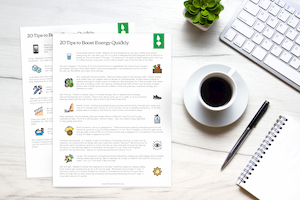With the increase of working from home, more and more of my clients are asking for productivity tips. Productivity while working from home is even one of the major sections in the Virtual Wellness presentations I’ve been giving to dozens of companies over the past few months. And while I do offer several ‘fancier’ tips, I think the most underutilized tip is to take mini-breaks all throughout the day. This concept, often called the Pomodoro technique – I’ll cover that below, is as simple as it sounds. But in today’s post, I’ll tell you why it works so well, how to do it on your own, and a few mistakes that people sometimes make while trying to implement mini-breaks.
Why mini-breaks increase productivity
Simply put, humans are not designed to sit in a chair and stare at a screen for 8-hour workdays (and certainly not for 12-14-hour workdays!). Several detrimental things happen when you’re sitting at your desk for too long, uninterrupted:
- Eye strain. Looking at one thing for long stretches of time is incredibly straining to our eyes, especially if that thing is a computer screen. Have you ever gotten that feeling of legitimately being tired in your eyes? If so, did you know that looking at the green in nature (like grass, trees, etc.) is the best way to counteract that? Even a few minutes of staring outside will help, so look away from that screen!

- Mental fatigue. Your brain has incredible capacity (thousands of times greater than the most complex computer!), but staying focused on the same topic for hours on end is nearly impossible. This is called “ vigilance decrement,” and you’ll notice it if you find yourself wanting to “just check in on Facebook” or feeling like you have to answer that one email now, in the middle of your most important task. Your brain is really asking for a little break, and that sense of accomplishment that you get when you check something off of your list (even if that is checking what your uncle’s ex-girlfriend-from-high-school’s dog’s name was … because clearly, that is critical right now) is tempting.
- Lack of enthusiasm. You know that feeling when you have 10 hours straight of Zoom calls, and your calendar shows NO gaps? Your brain automatically recoils from something like that, thinking that it’s in for a long haul of focus and not being too excited about it. But if you can pencil in a break, like 10 minutes of taking your dog outside or squeezing in a quick 15-minute walk, the entire day seems more appealing.
How to take mini-breaks
Well, just simply doing it is a great place to start! But if you need more specifics, start with timing:
- The most popular mini-break method is called the Pomodoro Technique, which is a system that advises working in 25-minute chunks or “pomodoros,” followed by 5-minute breaks. After four pomodoros, you take a 15-20-minute break. Interestingly, this was named when a university student used a tomato-shaped timer to try out the system on himself (pomodoro is Italian for tomato!).
- A recent study by DeskTime and the Draugiem Group found that the most productive individuals surveyed took 17-minute breaks every 52 minutes.
- I set up my schedule so my client sessions are 50-minutes long. If all goes well and I can stick to the time (which is a struggle for me, but I’m getting better!), I should hypothetically have a 10-minute break to refill my tea and water, stretch my legs, look away from the screen, and use the restroom.
- Don’t stress too much about the intervals I use, or anyone else uses. Just start somewhere and see what intervals work for you.

So now that you know about timing, what should you during mini-breaks? The answer is basically whatever you want, but not work. Don’t fool yourself into thinking that answering emails is a break (trust me, I’m speaking to myself here!), or you won’t get the real benefit of the mini-breaks. The key is to stop working, so you can fully work when the work session resumes.
Which brings me to the next question … What should you do between breaks? The key to the mini-break technique is that you are 100% focused on work between the breaks. It doesn’t increase your productivity to be checking Facebook all through your work break and half working … then take a mini-break where you fully dive into Facebook 😊. The Draugiem Group study states that during the work sessions, successful participants “were 100 percent dedicated to the task they needed to accomplish.” So, focus up, so that you can “earn” your break later!
Now it’s your turn … Do you take mini-breaks? What do you think about this method?




0 Comments
Trackbacks/Pingbacks